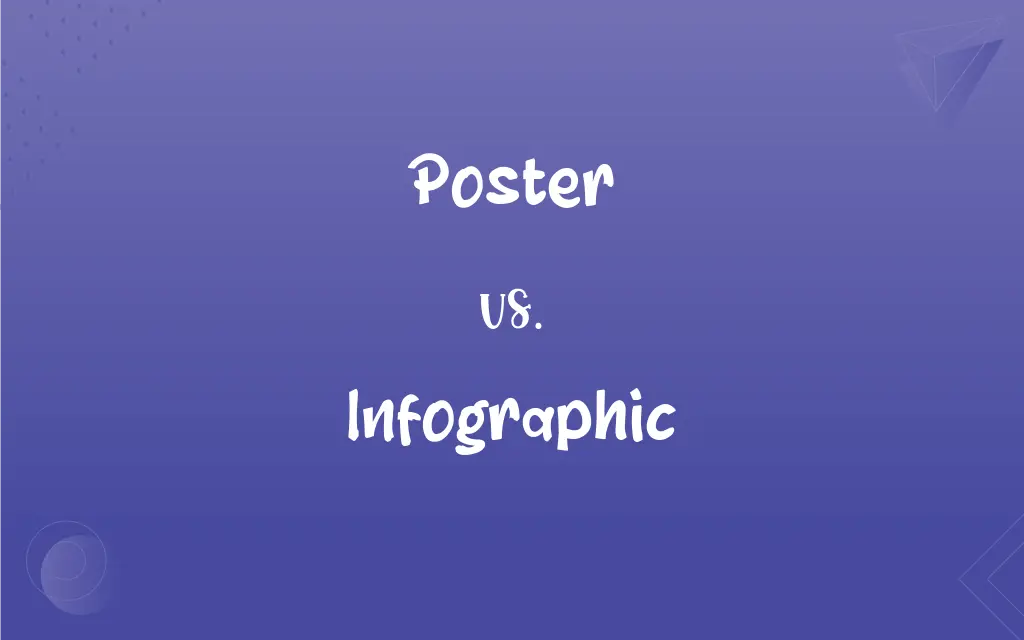Poster vs. Infographic: What's the Difference?
Edited by Harlon Moss || By Janet White || Updated on October 3, 2023
A Poster is a large printed picture or notice for display, while an Infographic visualizes data or information using graphics.

Key Differences
Posters, at their essence, are large printed materials designed for display. They could serve numerous purposes, from advertising a product or event to simply showcasing artwork. Infographics, on the other hand, are visual presentations of information. They aim to present complex data simply and understandably using graphics and minimal text.
When one looks at a Poster, the intent might be to catch attention or evoke emotion. It might promote a movie, concert, or a brand. Infographics, conversely, prioritize conveying information. For instance, an infographic might display the growth trajectory of a company or facts about a social issue.
A unique trait of Posters is their versatility. They can be artistic, informative, or persuasive. They often incorporate striking visuals and typography. Infographics, while also visually appealing, have the primary function of distilling complicated information or data into a digestible, visual format.
While both Posters and Infographics can be digital or printed, their formats might differ based on where they're intended to be displayed. Posters might adorn walls, billboards, or bus stops. Infographics are often found in presentations, reports, or websites, given their informative nature.
To recap, the major distinction lies in purpose. Posters largely aim to catch the eye or promote something, while Infographics aim to educate and simplify complex information through visuals.
ADVERTISEMENT
Comparison Chart
Primary Purpose
To display or promote.
To visualize and simplify data or information.
Content Type
Visuals with or without text.
Graphics with minimal text.
Common Uses
Advertising, art, announcements.
Reports, presentations, educational material.
Format
Can be digital or printed, large format.
Digital or printed, often longer in layout.
Interactivity
Typically static.
Can be interactive in digital form.
ADVERTISEMENT
Poster and Infographic Definitions
Poster
An individual or entity that uploads or publishes content.
The poster of the comment received a lot of backlash.
Infographic
A chart or diagram used to represent information.
He used an infographic in his presentation to explain the stats.
Poster
A large printed notice for public display.
The movie poster was captivating and drew a crowd.
Infographic
A visual representation of information or data.
The infographic detailed the effects of global warming.
Poster
A visual advertisement promoting an event or product.
Concert posters were plastered all over the city.
Infographic
A graphic design that tells a story or communicates a message.
The company’s growth was illustrated through an infographic.
Poster
A piece of paper detailing academic or professional research.
Students presented their research posters at the symposium.
Infographic
A tool to simplify complex information into digestible visuals.
The health benefits of fruits were displayed in an infographic.
Poster
An artistic representation meant for wall decor.
She bought a vintage poster from the flea market.
Infographic
An educational tool combining visuals and minimal text.
Teachers used infographics to teach history timelines.
Poster
A large, usually printed placard, bill, or announcement, often illustrated, that is posted to advertise or publicize something.
Infographic
A visual representation of information or data, such as a chart or a map, especially of information that is more easily imparted by such a representation than by written text.
Poster
An artistic work, often a reproduction of an original painting or photograph, printed on a large sheet of paper.
Infographic
A visual representation of information.
Poster
One that posts bills or notices.
Infographic
Relating to infography
Poster
One that travels in speed or with haste.
Poster
A picture of a celebrity, an event etc., intended to be attached to a wall.
He has posters of his favorite band, sports teams and holiday resorts up.
Poster
An advertisement to be posted on a pole, wall etc. to advertise something.
I saw a poster for the film on the side of a bus.
Poster
(internet) One who posts a message.
Some posters left the online message board after the squabble.
Poster
A shot that hits a goalpost, scoring one point.
Poster
A shot that hits a goalpost instead of passing into the goal.
We got three posters in the third and lost.
Poster
(basketball) A dunk over a defending player.
Poster
(dated) A posthorse.
Poster
(archaic) A swift traveller; a courier.
Poster
(transitive) To decorate with posters.
To poster the walls of a bedroom
Poster
A large bill or placard intended to be posted in public places.
Poster
One who posts bills; a billposter.
Poster
One who posts, or travels expeditiously; a courier.
Poster
A post horse.
Poster
A sign posted in a public place as an advertisement;
A poster advertised the coming attractions
Poster
Someone who pastes up bills or placards on walls or billboards
Poster
A horse kept at an inn or post house for use by mail carriers or for rent to travelers
FAQs
What's a basic definition of "Poster"?
A "Poster" is a printed or digital display conveying information or artwork, often designed for public view.
Are "Infographics" typically more detailed than "Posters"?
Infographics often contain detailed data visualizations, while posters can be simpler, but both can vary in detail.
And an "Infographic"?
An "Infographic" is a visual representation of information, data, or knowledge, using design elements to simplify complex ideas.
Can "Posters" be used for advertising?
Absolutely, many posters are designed specifically for advertising products, events, or ideas.
Are "Posters" always large?
No, while traditionally larger for public display, posters can vary in size, including smaller formats.
Are "Posters" primarily visual?
While visuals dominate, posters also often include text, headlines, or captions to convey messages.
How do "Infographics" simplify data?
They use visual elements like charts, graphs, and icons to represent data, making it easier to understand.
What tools are used to create "Infographics"?
Design software like Adobe Illustrator, Canva, or specialized infographic makers can be used.
Are "Infographics" better for digital or print?
Infographics can be effective in both digital and print, but digital versions can offer interactivity.
Can "Infographics" be interactive?
In digital formats, infographics can be interactive, allowing users to engage with the data.
Can a "Poster" be an "Infographic"?
Yes, if a poster visually represents and simplifies information, it can be considered an infographic.
Do "Posters" have a rich history?
Yes, posters have been used for centuries for various purposes, from propaganda to advertisements.
Is the main purpose of an "Infographic" to educate?
Often, yes. Infographics aim to communicate complex data in an easily digestible, visual format.
How do "Infographics" aid in understanding?
By visually organizing information, infographics can make patterns, trends, or relationships clearer.
Can "Posters" be collectible?
Yes, posters, especially vintage ones or those related to pop culture, can be collectible.
Are "Infographics" a modern concept?
While the term "infographic" is modern, visual representations of information have ancient roots.
Is a movie "Poster" purely decorative?
While decorative, a movie poster's primary goal is to advertise and generate interest in the film.
Can "Posters" be considered art?
Absolutely, many posters, especially those with artistic designs, are considered art pieces.
Why are "Infographics" popular in marketing?
Infographics can quickly convey complex information, making them valuable for audience engagement in marketing.
What material are printed "Posters" typically made of?
They are often printed on paper, but can also be on canvas, vinyl, or other materials.
About Author
Written by
Janet WhiteJanet White has been an esteemed writer and blogger for Difference Wiki. Holding a Master's degree in Science and Medical Journalism from the prestigious Boston University, she has consistently demonstrated her expertise and passion for her field. When she's not immersed in her work, Janet relishes her time exercising, delving into a good book, and cherishing moments with friends and family.
Edited by
Harlon MossHarlon is a seasoned quality moderator and accomplished content writer for Difference Wiki. An alumnus of the prestigious University of California, he earned his degree in Computer Science. Leveraging his academic background, Harlon brings a meticulous and informed perspective to his work, ensuring content accuracy and excellence.































































